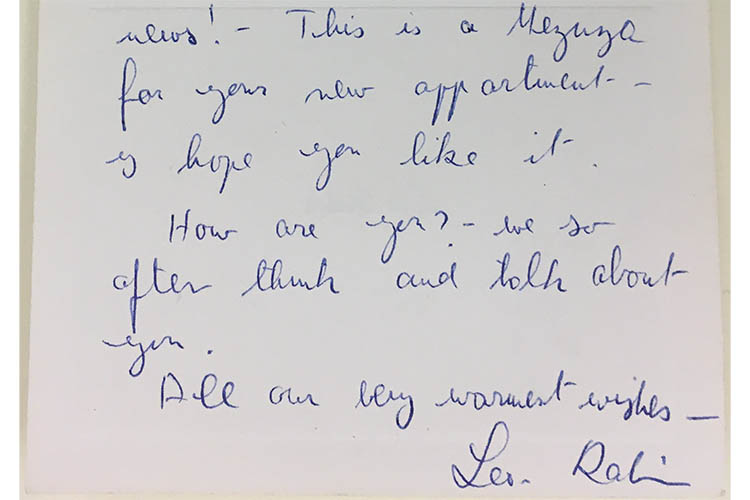Kamala Harris’ residence to display Jewish mezuzah from UC Berkeley
A sacred Jewish object called a mezuzah that is in the collection of UC Berkeley’s Magnes Collection of Jewish Art and Life will soon be hung in the official Washington, D.C., residence of Vice President Kamala Harris and her husband, Doug Emhoff.
Emhoff, who is the first Jew to live in an American executive mansion, announced Thursday that he had hung a mezuzah at the entrance to the vice presidential home last month. The one soon to be on loan from The Magnes will be displayed in another part of the historic home.
A mezuzah, which literally translates to doorpost, is a piece of parchment inscribed with Hebrew verses from the Bible that is housed in a case created especially to be affixed on doorposts.
It is one of the items that “make a Jewish home Jewish,” said John Efron, the Koret Professor of Jewish History at Berkeley and faculty director of the museum.
The Magnes mezuzah case comes from the museum’s 15,000-item collection of objects from the global Jewish diaspora. It is one of the largest collections of Jewish artifacts in the world and the largest maintained by a public research university.
“Two things are historic firsts,” Efron said. “You’ve got Emhoff, the first Jewish Second Gentleman, and the request is a first for The Magnes and UC Berkeley, which have never been asked to do something like this before.”
But choosing the particular item that would hang in Emhoff and Harris’ residence was no easy task.

Francesco Spagnolo, curator of The Magnes, holds the mezuzah that will soon be in the vice presidential residence. (Photo courtesy Greg Niemeyer)
The work began months ago when Francesco Spagnolo, curator of the museum, was contacted by the vice president’s staff: Was there something in the Magnes’ collection that would be appropriate to hang in the vice presidential mansion?
The piece had to have relevance to the couple, have an American story and be suitable to be hung next to a door in the open air in a busy official residence.
“It was sort of a curatorial mission impossible,” said Spagnolo, who is also an associate adjunct professor in the Department of Music.
Spagnolo soon landed on a mezuzah made after a design by a German-Israeli-American sculptor named Ludwig Yehuda Wolpert that Spagnolo thought touched so many parts of Jewish-American history that it felt like a natural fit to display in the vice presidential residence. Emhoff agreed.
The designer, Wolpert, found freedom and self-expression in America. He fled the Nazi regime for Palestine in 1933 before moving to New York City in 1956, where he led a workshop that made major contributions to the design of American Jewish ritual objects and places of worship.
The mezuzah was donated to The Magnes by the heirs of Alice Grossman, a veteran of World War II who immigrated to the United States from Russia when she was a child.
Beginning in 1950, Grossman was the English-language secretary to several Israeli ambassadors to the United States, including Yitzhak Rabin, who served as ambassador from 1968 to 1973 before becoming the 5th prime minister of Israel in 1974.
The day after Rabin became prime minister, his wife, Leah Rabin, mailed Grossman the mezuzah from Israel to celebrate Grossman’s move to a new New York City apartment.

In a note to Alice Grossman, mailed with the mezuzah, Leah Rabin wrote: “This is a Mezuzah for your new apartment – I hope you like it.” The letter is preserved in The Bancroft Library. (Image courtesy Bancroft Library)
In his second term as prime minister in 1993, Rabin worked closely with President Bill Clinton and Palestine Liberation Organization leader Yassir Arafat on the historic Oslo Accords.
And when Grossman retired in 1979, she eventually brought the mezuzah to her new home in San Francisco, where, years later, Harris would get her political start. When Grossman died in 2007, her sister donated the mezuzah to The Magnes.
“It is a mezuzah that connects with their personal history,” Spagnolo said of Emhoff and Harris. “It is a rare example of a Jewish ritual object that has touched the lives of several women in service. And it really intersects history with a capital H.”
The final details of the loan are still being settled, but The Magnes’ mezuzah is expected to be displayed at the vice presidential residence through the end of 2024.
At some point in the coming weeks, Spagnolo will get out a sturdy travel case, carefully load the mezuzah, courier it himself across the country and supervise the installation in the residence, where Emhoff and Harris will walk past the mezuzah many times a day.
The outer design of the mezuzah case itself is formed by the Hebrew letters in a blessing from Deuteronomy 28:6: “Blessed shall you be in your comings and blessed shall you be in your goings.” The inside is a scroll of sacred text from the Hebrew Bible about the centrality of the law, and eternal rewards and obligations for all.
“These words can resonate and be auspicious in everything that goes on,” at the Harris and Emhoff residence, Spagnolo said. “Both the blessing on the outside for those traveling the halls of power and the text on the inside, which very much speaks to humankind. … The idea of keeping certain principles in front of ourselves and trying not to derail. It is a reminder to do the best we can in life. It is an encouragement.”

